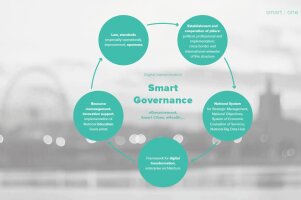Our society has recently undergone transformation from a closed and ideologically controlled to an open society. This change was local.
At the same time, we are now experiencing another, this time global, change that is much deeper. This change is related to digital transformation. The first adaptation was managed in an evolutionary way – by means of adapting rules. For example, the current legislation is gradually amended and supplemented through individual laws. On the other hand, digital transformation requires simplification of rules, which
in principle often means to recreate them and then digitalize them. Attempts to modify the current system result for instance in an inability to apply the services of shared economy. But that is one of the pillars of the digital transformation,
as we shall see.
Issues that we deal with by means of Smart Governance:
• Technology enables us to infl uence our environment quickly and almost without any limits
• Goods are accesible, to the extent that this ownership causes problems. For example cars – traffi c, parking
• Ownership ceases to indicate social status; this allows a shared economy
• In terms of values, our goals are still primarily profi toriented, often also in public services
• We have already exhausted some resources, or we have reached the limit of their exhaustion
• We have reached a point where our environment is unlikely to be able to restore iself while maintaining the present form of mankind
• Our society (the Czech Republic) is not yet suffi ciently prepared for this period
: Good and bad Smart City stories
Smart City environment that is in the centre of our attention is presented through stories. They describe a possible new form of public services. The quality of these stories is crucial at this stage. We help businesses to defi ne their off er correctly, while enabling future users to prepare for this off er. We also assist public administration
in adapting their environment.
Which stories are good? Those that describe a useful public service that brings new opportunities that save users time and resources. Which are not good then? Well, those that say – buy a sensor, then connect it through expensive connectivity to a closed individual system and create a situation where the citizen has to pay for this
trap. Regardless of the fact that these funds will be missing for their own development, child upbringing, caring for parents … Ignore that this situation brings the citizen closer to the risk zone where it is easy to become dependent on the social safety net. And that is the biggest tax eater.
All stories are technically built on a regional Big Data Hub instance. It collects the particular data structures and, depending on the authorization, also off ers them. The above-mentioned stories are even more complex when we realize that they provide exactly the data that can be evaluated in time, thus allowing improvement of
the service. Let’s have a look at one particular story:
The basic feature of Smart City services is openness. The Big Data Hub is an opportunity to create tools that support social, association and community activities, such as helping gardeners identify the risk rate for planting apricots at a specifi c site or providing support to beekeepers, or to communicate activities of tourists, seniors,
schoolchildren, or home care patients. It can receive data from home weather stations, fl ow meters, shop and service providers’ off erings, and the entire set of IoT devices. Thus, it can monitor the functional systems in a cottage colony so that water freezing in one cottage does not cause water shortage to other residents.
: New rules and limits for digital transformation
The rules are adapted to the common capabilities of service providers and users. If navigation was not of suffi cient quality in the earlier days, we introduced topography testing for taxi drivers. We have set a large amount of such measures and regulations.
At that time it was necessary, but today we have to reassess these measures and abolish those that are outdated. This will simplify the service, making it easier to digitize. It is by the combined eff ect of simplifi cation and technology that we gain the advan-tage of digital transformation. Only in this case will we achieve the fundamental goal of innovation, which is a new quality of service with a lower and conscious use of resources.
Digital transformation works with new technologies and at the same time with new organization charts. This is also related to new knowledge. A typical case is the sharing principle with which we have major legislative problems. Yet, it would allow, for
instance, a reduction in the number of cars operated and parked and the associated revitalization of our urban areas. In the whole context of change, we will infl uence the quality of life of both residents and visitors. And that is exactly the purpose of Smart City.


